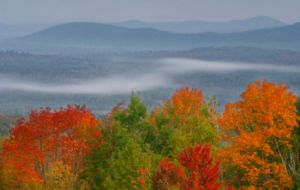MercoPress. South Atlantic News Agency
Climate change and higher levels of C02 making trees grow faster
 Forests in east US are “putting on weight” at the fastest rate in 225 years
Forests in east US are “putting on weight” at the fastest rate in 225 years A new study on trees and climate change, the Proceedings of the National Academy of Sciences has found evidence that forests in the Eastern United States are growing faster than they have in the past 225 years.
For more than 20 years forest ecologist Geoffrey Parker has tracked the growth of 55 stands of mixed hardwood forest plots in Maryland. The plots range in size and some are as large as 2 acres. Parker’s research is based at the Smithsonian Environmental Research Centre, 26 miles east of Washington.
Parker’s tree censuses have revealed that the forest is packing on weight at a much faster rate than expected. He and Smithsonian Tropical Research Institute postdoctoral fellow Sean McMahon discovered that, on average, the forest is growing an additional 2 tons per acre annually. That is the equivalent of a tree with a diameter of 2 feet sprouting up over a year.
Forests and their soils store the majority of the Earth’s terrestrial carbon stock. Small changes in their growth rate can have significant ramifications in weather patterns, nutrient cycles, climate change and biodiversity. Exactly how these systems will be affected remains to be studied.
The Parker and McMahon’s paper focuses on the drivers of the accelerated tree growth. The chief culprit appears to be climate change, more specifically, the rising levels of atmospheric CO2, higher temperatures and longer growing seasons.
Assessing how a forest is changing is no easy task. Forest ecologists know that the trees they study will most likely outlive them. One way they compensate for this is by creating a “chronosequence”, a series of forests plots of the same type that are at different developmental stages.
At SERC, Parker meticulously tracks the growth of trees in stands that range from 5 to 225 years old. This allowed Parker and McMahon to verify that there was accelerated growth in forest stands young and old. More than 90% of the stands grew two to four times faster than predicted from the baseline chronosequence.
By grouping the forest stands by age, McMahon and Parker were also able to determine that the faster growth is a recent phenomenon. If the forest stands had been growing this quickly their entire lives, they would be much larger than they are.
Parker estimates that among himself, his colleague Dawn Miller and a cadre of citizen scientists they have taken a quarter of a million measurements over the years. Parker began his tree census work Sept. 8, 1987—his first day on the job. He measures all trees that are 2 centimetres or more in diameter. He also identifies the species, marks the tree’s coordinates and notes if it is dead or alive.
By knowing the species and diameter, McMahon is able to calculate the biomass of a tree. He specializes in the data-analysis side of forest ecology. “Walking in the woods helps, but so does looking at the numbers,” said McMahon. He analyzed Parker’s tree censuses but was hungry for more data.
It was not enough to document the faster growth rate; Parker and McMahon wanted to know why it might be happening. “We made a list of reasons these forests could be growing faster and then ruled half of them out,” said Parker. The ones that remained included increased temperature, a longer growing season and increased levels of atmospheric CO2.
During the past 22 years CO2 levels at SERC have risen 12%, the mean temperature has increased by nearly three-tenths of a degree and the growing season has lengthened by 7.8 days. The trees now have more CO2 and an extra week to put on weight. Parker and McMahon suggest that a combination of these three factors has caused the forest’s accelerated biomass gain.
Ecosystem responses are one of the major uncertainties in predicting the effects of climate change. Parker thinks there is every reason to believe his study sites are representative of the Eastern deciduous forest, the regional ecosystem that surrounds many of the population centres on the US East Coast. He and McMahon hope other forest ecologists will examine data from their own tree censuses to help determine how widespread the phenomenon is.




Top Comments
Disclaimer & comment rulesCommenting for this story is now closed.
If you have a Facebook account, become a fan and comment on our Facebook Page!